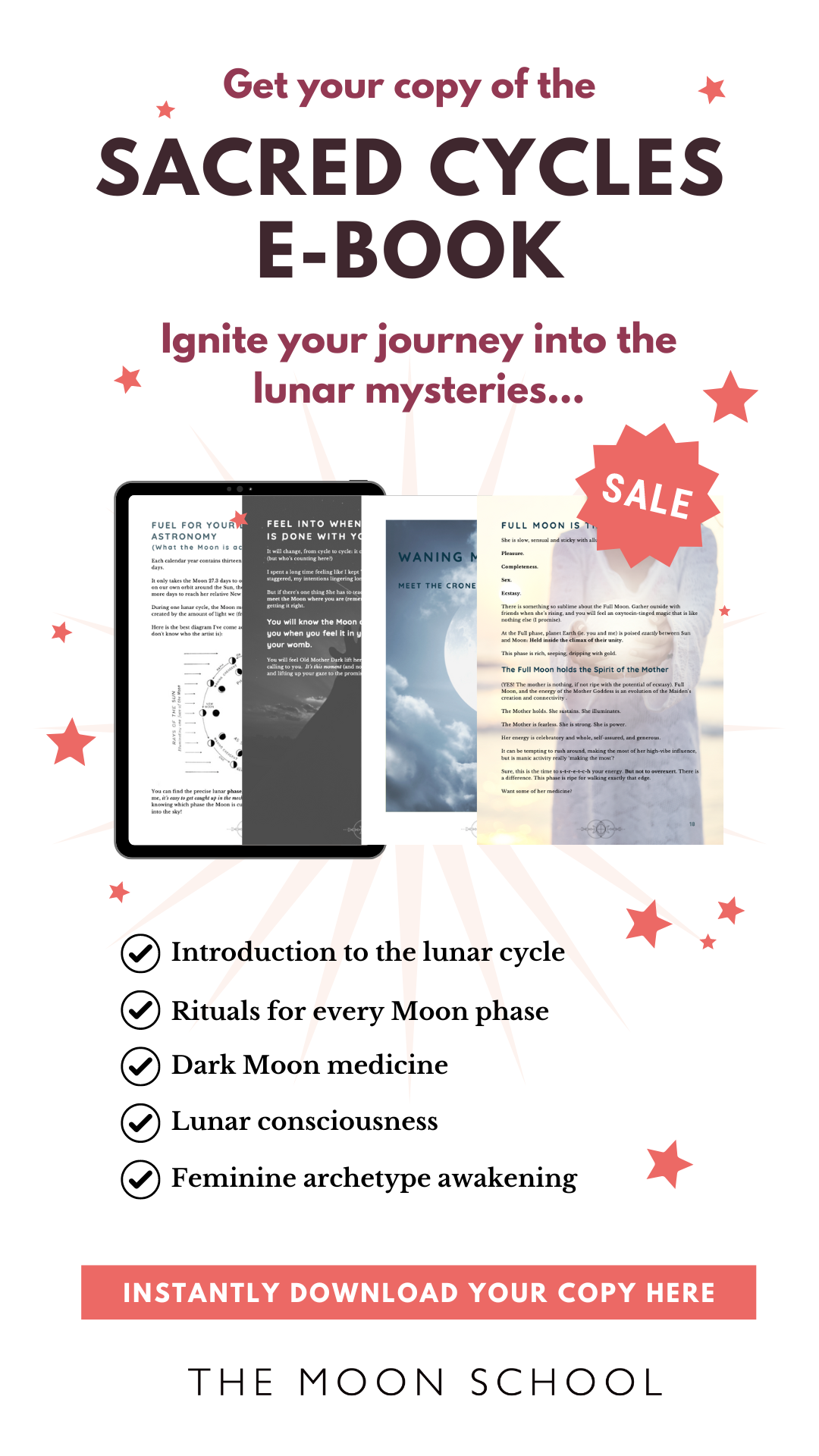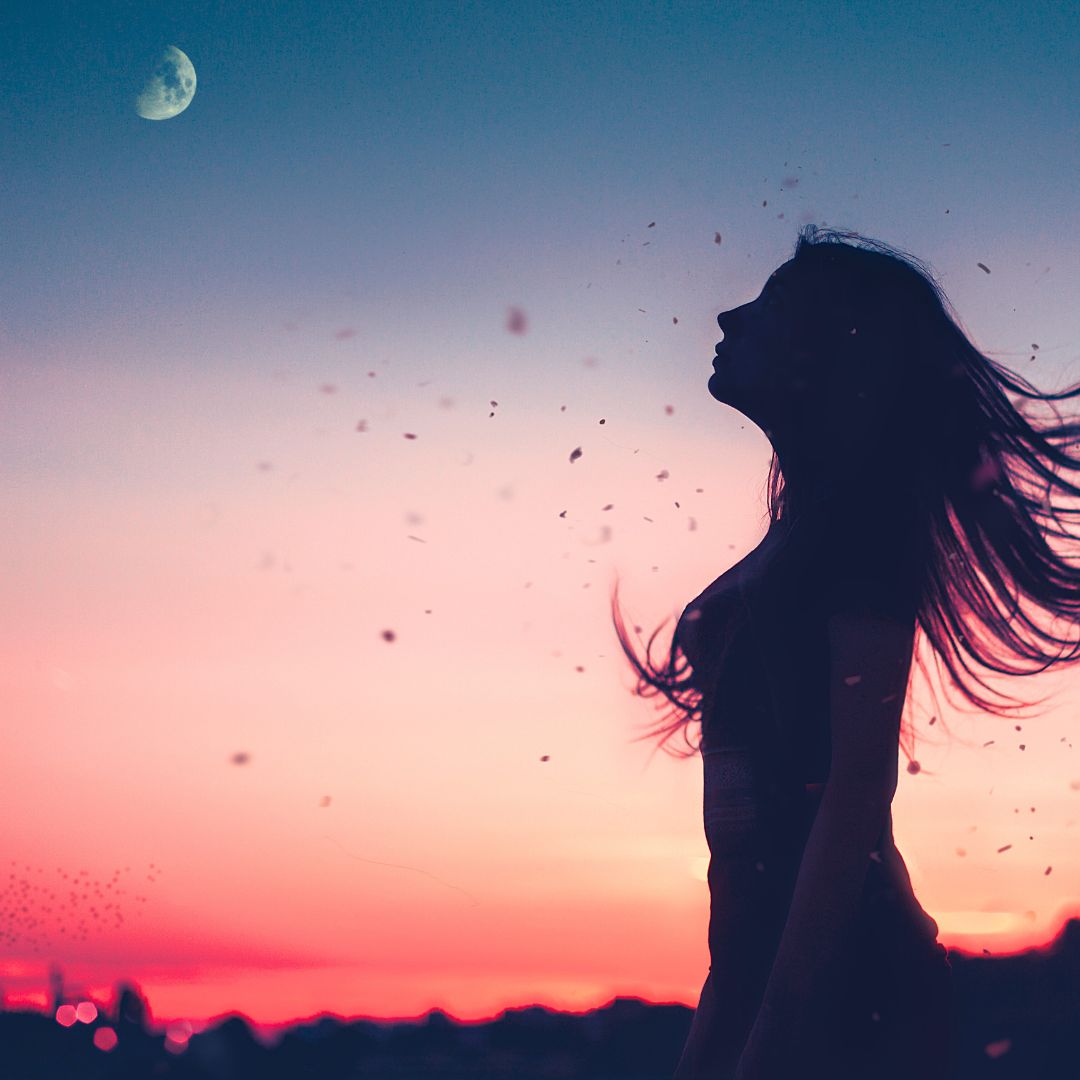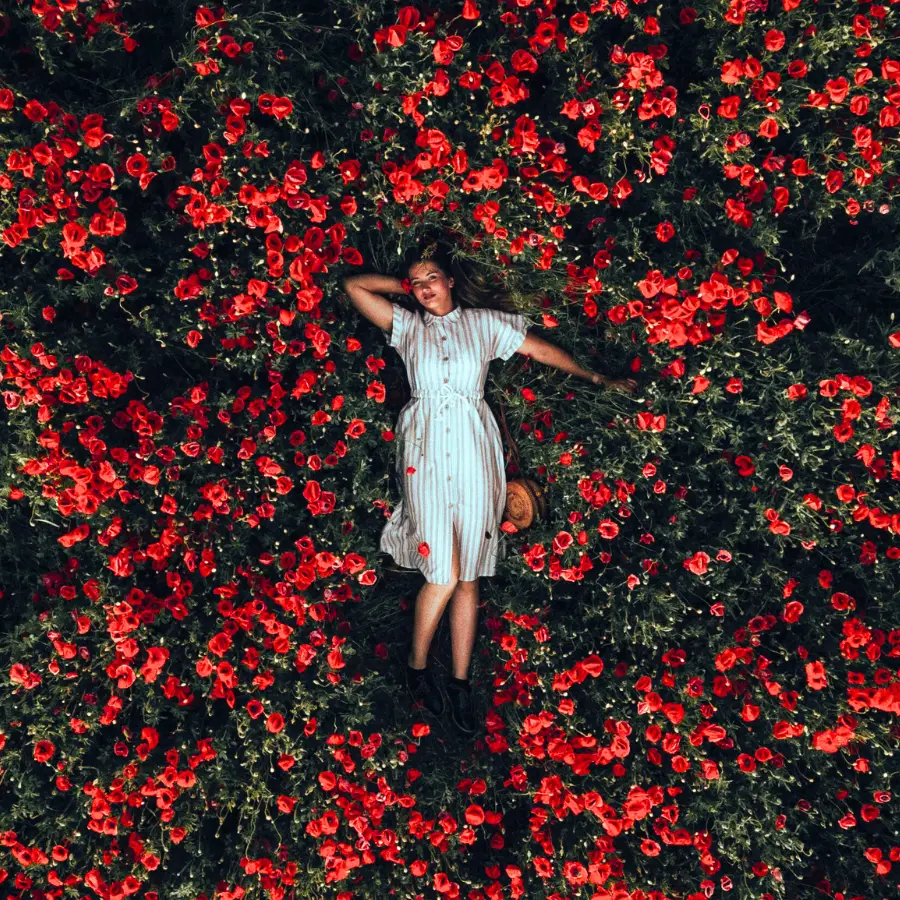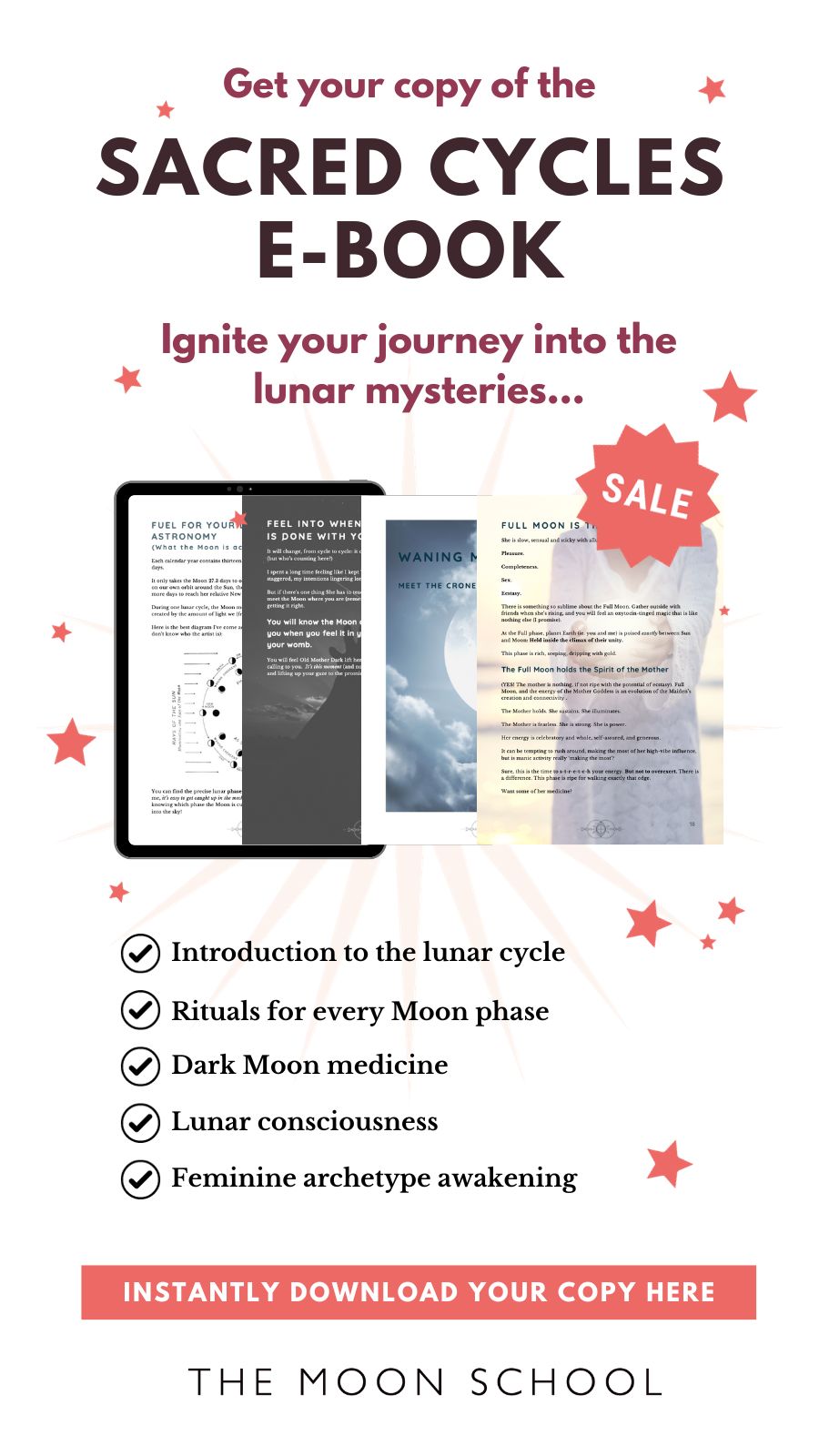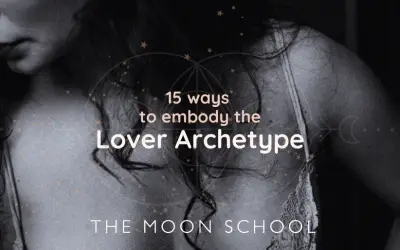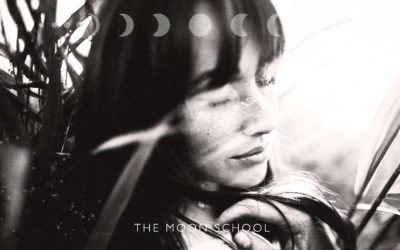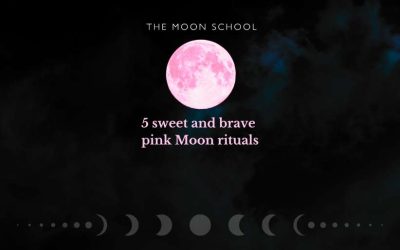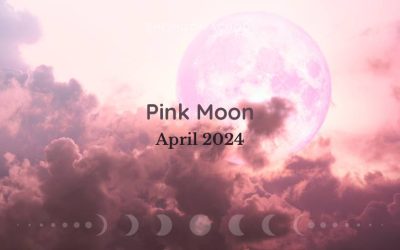How does your blood flow…?
The Moon has long been associated with the menstrual cycle in cultures all around the world.
From ancient times to the present day, many people have recognized that the phases of the Moon have a powerful influence on the female body and its reproductive system… but are the Moon and the menstrual cycle really connected?
This connection between the Moon and the menstrual cycle has been the subject of SO much fascination and speculation, with many theories, opinions and beliefs about how the two cycles are connected.
Science continues its search and struggle to find definitive evidence that menstrual and lunar cycles are connected. And all the while, many of the menstruating women out there know their blood cycle is connected to the Moon.
For many, many women, the connection is something we experience as a monthly truth.
Yet for each study that finds a link between menstrual patterns and the lunar phases, another finds no relationship at all.
So let’s look at this from all angles – from the scientific to the spiritual. And figure out if there is a connection, and if so, what it looks like…
Does the moon affect women’s menstrual cycles?
After analysing 7.5 million menstrual cycles, a recent study by period tracking app Clue found there’s no correlation between the Moon cycle and the female menstrual cycle.
“Looking at the data, we saw that period start dates fall randomly throughout the month, regardless of the lunar phase.” Says Dr. Marija Vlajic Wheeler.
Pretty compelling, eh?
Yet in a 2021 study published in Science Advances, researchers found that for some women, their periods DID sync with the Moon cycle, during certain points in their lives.
A 1986 Scandinavian Study of 826 women with a normal menstrual cycle, found that a large proportion of them experienced menstruation around the new moon (28.3%). At other times during the lunar month, the proportion of women menstruating ranged between 8.5–12.6%.
The question of whether menstrual cycles sync with the Moon doesn’t have a straightforward “yes” or “no” answer. It’s possible some women temporarily synchronize, whilst others don’t. Your period may line up with the new Moon sometimes. At other times in life, you may bleed when the Moon is full.
More research is clearly required. Yet could it be that menstruation is affected by many other environmental factors too? That it isn’t as straightforward as the findings suggest? That there’s no simple “yes” or “no” to the question of whether lunar and menstrual cycles are connected.
Possible causes of irregular periods or disrupted menstrual cycles
We live in a world where menstrual cycles are heavily influenced by lifestyle choices, biological/medical conditions and environmental factors. Modern life constantly bombards women with SO many factors which could, quite possibly, upset any potential correlation between menstruation and the Moon. Factors such as:
-
Stress
-
Weight gain or loss
-
Exercise routine or level of physical activity
-
Nutrition and diet
-
Sleep patterns
-
Underlying medical conditions (e.g. PCOS)
-
Medications, including birth control pills
-
Age
-
Artificial light and exposure to narrow light spectrums (i.e blue light)
-
Travel or changes in time zones
-
Consumption of caffeine, alcohol, or other substances
-
Pregnancy or postpartum period
-
Menopause transition
-
Breastfeeding
-
Environmental toxins or chemicals
What happens when you begin to strip back these factors? What would your menstrual cycle look like, if you came off hormonal birth control, minimized screen time, cut out caffeine, and eliminated toxic cleaning products?
And how can we really ever know?
Is the menstrual cycle related to the lunar cycle?
Whether or not the menstrual cycle is affected by the lunar cycle, the two are related because they share so many similarities.
Have you ever noticed that your menstrual cycle seems to align with the phases of the moon? It’s not just a coincidence. The moon and menstrual cycles have been linked for centuries, and there is scientific evidence to support the connection.
The average menstrual cycle lengths are between 27 and 30 days, which is very close to the length of the lunar cycle, which is 29.5 days.
This means that the Moon completes a full cycle from new Moon to full Moon and back to new Moon again in about the same time it takes for a woman to complete a menstrual cycle. This is why some people refer to the menstrual cycle as the “moon cycle.”
Lunar cycles move through four distinct phases:
- New Moon
- Waxing Moon
- Full Moon
- Waning Moon.
Human menstrual cycles also move through four phases:
- Menstruation (bleeding phase)
- Follicular phase (pre-ovulation)
- Ovulation
- luteal phase (pre-menstruation)
The phases of the Moon cycle and the phases of the menstrual cycle share a similar rhythm, and whether or not they align in real time, their energy corresponds.
What are the four phases of the menstrual cycle?
The four phases of the typical menstrual cycle are:
1. Menstruation (days 1-5) This is the phase when the uterine lining is shed. It occurs in response to decreasing levels of the hormones estrogen and progesterone. During the menstrual phase, women often feel low in energy and emotionally introspective.
2. Follicular phase (days 6-13) Estrogen levels begin to rise, stimulating the development of follicles in the ovaries. One follicle will mature and release an egg. This is usually felt as rising energy, greater curiosity, and outward focus.
3. Ovulation (around day 14) At mid-cycle, high levels of estrogen trigger surges of luteinizing hormone and follicle-stimulating hormone from the pituitary gland. This causes the mature follicle to rupture and release the egg. The ovulation phase is peak fertility! At this point in her reproductive cycle, a woman feels open, erotic, sociable and alive!
4. Luteal phase (days 15-28) With the follicle now empty, it transforms into the corpus luteum. This structure secretes progesterone and estrogen to thicken the uterine lining in preparation for potential pregnancy if the egg is fertilized. If implantation doesn’t occur, progesterone and estrogen levels drop, triggering menstruation and the start of a new cycle approximately 14 days after ovulation. This phase is usually felt as a need to retreat and withdraw. It’s also when many women experience symptoms of PMS.
If you’ve ever worked consciously with your menstrual cycle, you’ll understand that these phases are a kind of blueprint around which you can organize your life as a woman.
The different energy in each phase of your menstrual cycle can be harnessed to support your creative efforts, personal goals and desires. Let’s take a closer look at these phases, and how the menstrual and lunar cycles relate.
Menstruation (bleeding phase)・Waning crescent・new Moon
The energy of menstruation corresponds closely with the waning crescent and new Moon phases of the lunar cycle. These lunar phases symbolize the very end of the cycle moving into a new beginning, just as the first days of menstruation mark the end of the previous menstrual cycle, to make way for a new start.
The waning crescent moon and bleeding phases are both times of release, renewal and darkness, in preparation for a new cycle. It’s time for consciously releasing outmoded beliefs, attitudes, and behaviours, along with the bodily release of blood.
This phase of the lunar and menstrual cycles provides the opportunity for rest, low-key activities and nurturing self-care to replenish before energies begin increasing again.
It’s important to do this work now, so that anything that no longer serves us isn’t carried over into the next cycle.
At the bleeding times, intuition is heightened – the two hemispheres of the brain are most actively communicating, so intuitive insights and messages may be received.
As bleeding slows, it’s time to consciously set intentions for the new cycle and emerge from this time of retreat.
The waning crescent, dark Moon, and new Moon phases of the lunar cycle align with the wise woman, or crone archetype.
Also read: : 12 Ways to Meet your Wise Woman / Crone Archetype
Follicular Phase (pre-ovulation )・Waxing crescent・First quarter・waxing gibbous Moon
The energy of the follicular phase of the menstrual cycle corresponds with the waxing crescent, first quarter, and waxing gibbous Moon phases of the lunar cycle.
Just as the Moon begins to wax and grow larger after the darkness of the new Moon, the follicular phase marks a time of growth and development as estrogen levels rise, stimulating the maturation of egg-containing follicles in the ovaries.
One follicle will be selected to reach maturity and rupture to release an egg. This parallels the increasing illumination of the Moon as it waxes from crescent to gibbous.
Emotionally, it can be a time of new potential and burgeoning ideas as creative energies start to build, similar to the waxing moonlight.
By the first quarter and gibbous phases, energies are increasing steadily as ovulation approaches, signified by the nearly half or three-quarters illuminated moon.
Physically, women tend to feel more dynamic and active, and you likely feel more open to the possibilities around you. You likely feel increasingly creative, enthusiastic and eager to make plans and put them into action.
Rising confidence enables you to attract more of what you desire into your life.
The waxing crescent, first quarter and waxing gibbous Moon phases of the lunar cycle align with the maiden archetype.
Also read: 15 Ways to Embody Your Inner Maiden
Ovulation・full Moon・waning gibbous Moon
The energy of ovulation corresponds closely with the full Moon and waning gibbous Moon phases of the lunar cycle.
As the Moon reaches full illumination, this signifies peak energy and maximum light being emitted. In the same way, ovulation marks the climax of the menstrual cycle with surges of luteinizing hormone causing the mature follicle to rupture and release the egg.
It is a moment of potential fertility and creation as the egg is available for up to 24 hours to be fertilized.
Just as the full Moon radiates strongly, a woman’s sexuality and creative forces are heightened around ovulation.
Physically, this is when women are at their strongest and most alert, whilst feeling emotionally energized and confident.
High, stable estrogen levels mean that you likely feel open, sociable, and communicative, making this the best time in the cycle to throw a party, go on dates and schedule meetings. This is because communication skills are at their sharpest – you’re thinking quickly, calmly and logically, and have the stamina to keep going!
You may be more aware of your appearance and become flirtatious and sexually confident (this is your most fertile phase).
As the Moon begins waning from full to gibbous again, lunar energy starts to decrease slowly. Likewise, if the egg is not fertilized during this window, the corpus luteum will degenerate and progesterone/estrogen levels fall, signalling the end of this phase.
Emotionally, it can feel like entering a time of reflection. The end of that peak, before the descent towards the cycle’s ending.
The full Moon and waning gibbous Moon phases of the lunar cycle align with the mother archetype.
Luteal phase (pre-menstrual phase)・waning gibbous・last quarter・waning crescent Moon
The energy of the luteal phase corresponds with the waning gibbous, last quarter, and waning crescent Moon phases. As the Moon enters its waiting gibbous stage, the illuminated portion shrinks noticeably each night.
Similarly, after ovulation, the corpus luteum produces progesterone and estrogen to prepare the uterine lining. However, if no implantation occurs, hormone levels start to decline leading up to menstruation.
This echoes the Moon’s decreasing light as it wanes towards the last quarter and beyond. Many women start to experience a decline in physical and emotional energy, and towards the end of the cycle, premenstrual symptoms may arise such as breast tenderness and mood changes from the dropping hormones. You may become anxious, irritable and defensive in an attempt to push others away, in order to create the space you need to be alone.
Emotionally, a sense of closure and release begins to build in anticipation of the next cycle.
You may feel the desire to perform self-care rituals, to restore and honour the body and aid in its natural cleansing and repair. Emotionally, these kinds of activities (long hot baths, massage, facials, manicures, etc.) help us to feel soothed and grounded.
You likely begin to seek more comfort and the familiar.
The particular ratio of hormones at this phase increases our attention to detail, and you may become absorbed in domestic chores and feel the urge to take stock and have a good clear out.
Emotionally, it’s also time to take stock and reflect on the cycle, which can result in feeling either proud of what you’ve achieved or disappointed in yourself. This reflection prepares you to strip back and release any aspects of yourself no longer desired or required, as you anticipate the release that comes with your next bleeding phase.
The Luteal (pre-menstrual) phases menstrual cycle and the waning gibbous, last quarter, waning crescent Moon phases of the lunar cycle align with the wild woman archetype.
Also read: Best Ways to Embody the Wild Woman Archetype
Bleeding on the new Moon vs blessing on the Full Moon…
The framework described above, where menstruation occurs around the new Moon and ovulation ad the full Moon, is often referred to as the “white Moon cycle”. This tends to be a pretty common menstruation pattern or dare I say it… something that many women think they need to aim for.
But there are other bleeding cycles too, each with its own gifts and medicine, usually offering exactly what a woman needs at that point in her life. The cycles are:
White Moon cycle
Also known as “white Moon witches”, women with a white Moon cycle bleed during the new or waning moon, and ovulate during the full Moon.
This cycle is usually experienced by women in their most fertile years or phases, or during early motherhood, and is generally perceived to be the most common human menstrual cycle.
You may like: Tips For Working WIth Your White Moon Cycle
Red Moon cycle
Also known as “red Moon witches”, women with a red Moon cycle ovulate during the new Moon, and bleed during the waxing gibbous or full Moon. Because the red Moon cycle seems to counter the ebb and flow of the lunar cycle, it can feel “wrong” to some.
Yet this powerful human menstrual cycle pattern is often associated with the healers, medicine women and shamans of the world.
You may like: How to Harness the Power of Your Red Moon Cycle
Pink Moon cycle
Women with a pink Moon cycle ovulate during the waning Moon, and bleed during the waxing Moon phase.
Often women who have had a white Moon cycle will transition to the pink cycle when they’re entering a new phase of their own self-realisation.
Women who are used to giving, providing, and nurturing others, and are moving away from this stage of life (even momentarily) may find themselves in a pink Moon cycle.
Purple Moon cycle
Women with a purple Moon cycle ovulate during the waxing Moon, and bleed during the waning Moon phase.
Often women who have had a red Moon cycle will transition to the purple cycle when they’re ready to release aspects of themselves to make space for something new.
Women who have done a lot of inner work, and become proficient in navigating their inner world may find they are ready to emerge into the world in a new way, and this can coincide with her experiencing purple cycles.
Changes in menstrual cycle length
There are many reasons for changes in the length of your menstrual cycle, including stress, changes to diet, physical exertion, hormonal birth control, and certain health conditions. Puberty, pregnancy and perimenopause also affect the reproductive cycle. As does – as many women will tell you – the advent of lunar eclipses and very big supermoons.
So it’s not only possible for menstrual cycle length to change, but can happen pretty often.
Whether or not the lunar phases influence menstruation, they may be a factor when it comes to your cycle length changing, along with many others.
Can I synchronize my menstrual cycle with the Moon?
It is theoretically possible to synchronize your menstrual cycle with the lunar cycle, but it may not be easy, reliable or even what’s actually best for your body. There’s a myth that the white Moon cycle is somehow more desirable, so some women seek to synchronize their menstrual cycles with it.
Yet human biology is intelligent. Your body does things for a reason, so playing around with it to synch up with lunar influences could do more harm than good.
That said, exposure to natural sunlight and moonlight can help entrain circadian rhythms and hormones like melatonin, which regulate the menstrual cycle. Sometimes women do find that by working with these natural cycles, they synchronize their menstrual cycles with the cycles of the Moon.
Ebb and flow is your natural state…
How deep you want to dive into any of these phases is up to you.
Expect any alignment between the lunar and menstrual cycles of your own body to change, according to where you are on your journey. But the basic pattern and rhythm of both of these moon cycles tends to hold true for all women, so it’s important to remember that the ebb and flow is your natural state.
Modern society may demand a single, relentless, progressive pace, but that has never been our natural, female way – our bodies tell us so!
Once you have an awareness of this rhythm, shared by the lunar and menstrual cycles, it’s easy to tune into your body and emotions and then respond in whatever way is needed most.
Honouring the female cycles of fertility and menstruation is the responsibility of each single one of us, and is one of the most vital and practical ways we can keep on encouraging the awakening of the divine feminine energies within.
Dive deeper with one of these related articles…
Now, tell me how this lunar and menstrual phase knowledge is landing for you!
Up until now, has your cycle been a friend, or a foe? Leave me a comment and let me know where you are on your journey…
Kat
X



